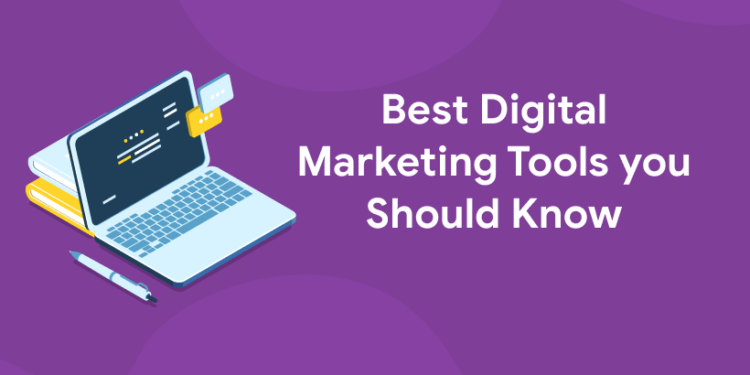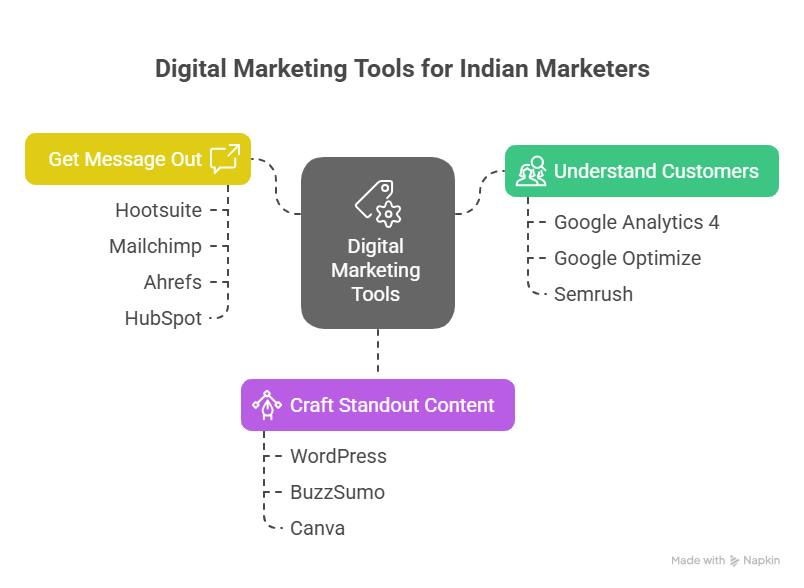Table of Contents
2025 is a whirlwind, especially in India where businesses are jumping headlong into online ads to get a piece of the internet pie. Whether you run a small cafe in Kochi or a fintech startup in Mumbai, the right digital marketing tools can make or break you. I have spent years figuring out what works in this crazy world and I have curated 10 tools that stand out for helping you understand your customers, create content they love and get your brand noticed. From SEO tools to social media platforms, these will help you thrive in content marketing India and beyond. Let us get into what makes these tools essential for 2025.
Discover the power of performance marketing! Join Free Demo Course Here!
Why These Tools Matter
India’s digital ad spend is going through the roof, with 65% of businesses increasing budgets. But with so many platforms and trends, it is easy to get overwhelmed. These tools simplify your work so you can focus on strategy not juggling tasks. They are grouped by what they do best: understanding your audience, creating content that stands out and reaching more people. Think of this as your roadmap to smarter marketing in a year where being different is harder than ever.
Tools to Understand Your Customers
1: What is the primary goal of SEO (Search Engine Optimization)?
Great marketing starts with knowing who you are talking to. These tools give you a clear picture of your audience, from their clicks to their preferences, so you can tailor your campaigns like a pro.
-
Google Analytics 4 (GA4):
This free tool is like having a crystal ball for your website or app. It shows you how visitors interact with your content, say, how many Chennai users browse your “stock market course” page or how long Delhi shoppers linger on your “gold jewelry” shop. GA4’s AI predicts trends, like which users might sign up for a “Demat account” campaign, and its cross-device tracking follows customers from phone to laptop. You can set up custom alerts to track specific goals, like downloads of a “Kerala travel guide,” and pair it with Google Ads to see which ads drive sales. I have used GA4 to tweak campaigns for Indian startups, and its insights are game-changers for spotting what works.
-
Google Optimize:
Ever wonder if a green “Buy Now” button outperforms a red one? Google Optimize lets you test different versions of your site, like headlines for a “Montessori school in Bangalore” page or CTAs for an e-commerce store. It is easy to set up, connects with GA4 for detailed results, and helps you figure out what converts best. For example, I tested two layouts for a Hyderabad restaurant’s booking page and boosted reservations by almost 15%. Run tests for a couple of weeks to get solid data, and you will see why this tool is a must for fine-tuning your site.
-
Semrush:
Semrush is your spy in the SEO world, revealing what your competitors are doing right. It digs into keywords driving traffic to “best trading apps” sites, shows who is linking to “SIP investment” blogs, and audits your site for issues like slow load times. For Indian marketers, its local keyword tracking helps you rank for “content marketing India” or “Pune tech events.” I haveve used its Content Gap tool to find untapped keywords for a client’s blog, pushing their rankings up in weeks. It is pricier, but the insights are worth every rupee for staying ahead.
Why They Are Essential: These digital marketing tools turn guesswork into strategy. Start with GA4 to see who’s visiting your site, then use Optimize and Semrush to make every click count.
Become an AI-powered Digital Marketing Expert
Master AI-Driven Digital Marketing: Learn Core Skills and Tools to Lead the Industry!
Explore CourseTools to Craft Standout Content
Content is how you connect with your audience, and it needs to grab attention fast. These tools help you create blogs, visuals, and posts that resonate, whether you are in Mumbai or Madurai.
-
WordPress:
Running 43% of websites, WordPress is a marketer’s best friend for creating content without needing a tech degree. You can whip up a blog on “best SIP plans in India” or a landing page for “online yoga classes” using its simple editor. Plugins like Yoast guide you to optimize for SEO 2025, ensuring your “Montessori materials” post ranks high. I’ve built sites for Indian SMEs with WordPress, adding Hindi or Tamil versions to reach local readers. Its themes and security features keep your site looking sharp and safe, making it a no-brainer for content creation.
-
BuzzSumo:
This tool is like a treasure map for content ideas. It shows which articles or Reels on “Hyderabad street food” are blowing up on social media, helping you craft posts that get shared. You can also find influencers talking about “stock market basics” to partner with for your campaign. For content marketing India, BuzzSumo’s regional filters highlight what’s trending in Kerala or Delhi, so your content feels local. I once used it to spot a viral topic for a client’s blog, doubling their traffic in a month.
-
Canva:
Canva turns anyone into a design wizard, creating visuals that make your brand pop. Design Instagram posts for “gold jewelry online” or banners for “Kerala tourism packages” with its drag-and-drop templates. Its Brand Kit keeps your colors and logos consistent, and festive templates for Diwali or Onam resonate with Indian audiences. I have used Canva to create Reels for a Pune startup, boosting their engagement by 20%. It’s free to start, and the pro version unlocks animations for next-level content.
Why They Are Essential: Compelling content builds your brand’s story. Try WordPress for blogs or Canva for quick visuals to see instant impact.
Discover the power of performance marketing! Join Free Demo Course Here!
Tools to Get Your Message Out
You have got the content, now make sure it reaches your audience. These digital marketing tools amplify your reach, turning strangers into followers and leads into loyal customers.
-
Hootsuite:
Social media can feel like herding cats, but Hootsuite keeps it under control. Plan posts for “Delhi food festivals” or “Pune tech startups” across Instagram, Twitter, and LinkedIn, and check analytics to see what’s clicking with your Indian audience. Its social listening tracks brand mentions, so you can jump into chats about “online yoga classes.” I have used Hootsuite to schedule a month’s posts for a client, freeing up their time for strategy. The team features are great for agencies managing multiple brands.
-
Mailchimp:
Email is still a powerhouse for connecting with customers, and Mailchimp makes it easy. Build newsletters to promote “Montessori courses in Bangalore” or follow up with “SIP investment” leads using sleek templates. Its automation sends welcome emails to new subscribers, and segmentation lets you target users who clicked “gold jewelry ads.” I have seen Indian SMEs double open rates with Mailchimp’s analytics. The free plan is perfect for startups testing email marketing 2025.
-
Ahrefs:
Ahrefs is an SEO beast, helping you rank for “best trading apps in India” or “content marketing India.” Its keyword research uncovers high-value terms, and the backlink checker shows who’s linking to “stock market course” sites, so you can pitch guest posts. For Indian marketers, its rank tracker monitors local searches like “Kerala tourism.” I have used Ahrefs to boost a client’s blog rankings by targeting overlooked keywords. Regular audits keep your site’s SEO health in check.
-
HubSpot:
HubSpot is your lead-generating sidekick, turning visitors into customers with ease. Its CRM tracks “stock market course in Malayalam” leads, while automated emails nurture inquiries about “online yoga classes.” Build landing pages for “gold jewelry e-commerce” with forms to capture emails, and use analytics to optimize conversions. I have helped Indian businesses grow their lists with HubSpot’s free CRM, which integrates with GA4 for a full marketing view. It is a lifesaver for scaling campaigns.
Why They Are Essential: These digital marketing tools put your brand in front of the right people. Start with Hootsuite’s free plan to streamline your social posts.
Key Takeaway
These digital marketing tools are your toolkit for owning the marketing game. Whether you are analyzing with GA4, designing with Canva, or reaching out with Mailchimp, each one helps you work smarter. Pick one to start, maybe WordPress for a blog or Hootsuite for social, and build from there. In a year where India’s digital scene is hotter than ever, these tools will keep you ahead of the curve. Want more ideas? Explore our digital marketing course to sharpen your skills!
Frequently Asked Questions
What are the top digital marketing tools for 2025?
GA4, Semrush, and Hootsuite lead the pack for digital marketing tools 2025, covering analytics, SEO, and social media. They help Indian marketers create campaigns that drive results.
Is Google Analytics 4 suitable for beginners?
GA4’s free platform is beginner-friendly, tracking user behavior for SEO tools 2025 success.
How does WordPress boost content marketing?
WordPress’s CMS and Yoast plugin optimize blogs for content marketing India. Its multilingual support reaches Hindi or Tamil audiences effortlessly.
What makes BuzzSumo stand out for content creation?
BuzzSumo finds trending content, like viral “SIP investing” posts, for digital marketing tools 2025. Its regional filters help Indian marketers craft locally relevant content.
Can Hootsuite improve social media engagement?
Hootsuite schedules posts and its analytics pinpoint peak times for Indian audiences, maximizing reach.
Is Mailchimp effective for email marketing in India?
Mailchimp’s templates and automation make email marketing 2025 a breeze for nurturing “yoga class” leads. Its free plan suits Indian startups building subscriber lists.
What sets Semrush apart for digital marketers?
Semrush’s SEO, PPC, and audit tools optimize “e-commerce in India” campaigns for digital marketing tools 2025. Its competitor insights give Indian marketers a winning edge.













